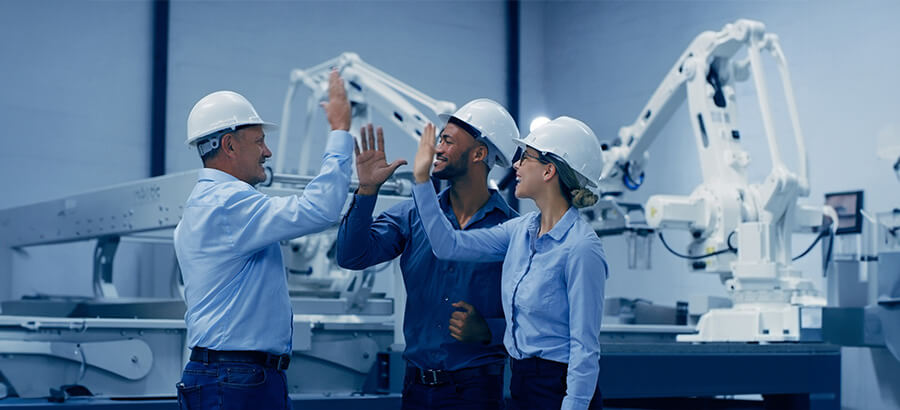Using artificial intelligence (AI) in manufacturing can significantly improve productivity, reduce equipment failure, increase production efficiency and help identify new business opportunities. The area of AI that manufacturers need to explore to drive their factories into the future is machine learning (ML). It is estimated by McKinsey that 40% of the potential value that could be created from analytics comes using ML techniques,
However, many business leaders are unsure where to apply ML to reap the greatest rewards. Implementing AI requires significant investment in technology infrastructure and staffing as well as major change management initiatives to ensure value is achieved. Having an ERP system in place can be a major advantage when considering how and where to start an AI/ML project.
What is Machine Learning
ML is the computing engine behind AI and gives computers the ability to make sense of, and learn, from data to perform specific tasks without manual interference. ML systems can identify patterns from the large amounts of structured and unstructured business and industry data that companies increasingly collect, and provide analysis and insights to users to help their decision-making.
The move by manufacturers towards Industry 4.0 has given ML significant impact in recent years. The Industry 4.0 paradigm encourages the usage of smart sensors, devices, and machines to enable smart, connected factories that continuously collect data from the production process, delivering information to make decisions that support production in real time.
Manufacturing and AI
Manufacturing is one of the industries that can benefit the most from AI and ML. Smart factories can greatly reduce unplanned downtime, improve product design, increase efficiency, and improve product quality and worker safety.
Key enablers of AI that are now economically viable to use are:
- smart sensors;
- the Internet of Things which can manage a large amount of data from all aspects of production;
- cloud computing which enables internet connections to store, access, and process data.
Nine areas where AI can help manufacturers
There are several ways in which data and AI can be applied in the manufacturing industry.
1. Product development
When designing a new product or improving an existing one, extensive data analysis is required. ML solutions can help collect and analyze product data to understand customer needs, uncover hidden problems, and identify new business opportunities. Using ML, companies can also reduce the risks associated with developing new products through the insights that ML generates.
2. Quality control
ML models can be trained on data from production lines to identify patterns and deviations associated with product defects. By analyzing real-time data from sensors, cameras, and other sources, manufacturers can detect quality issues early in the production process, reducing waste and improving product quality.
3. Logistics and inventory management
ML solutions can analyze historical data on supply chain operations, including inventory levels, demand patterns, transportation costs, and supplier performance. This can help optimize inventory management, identify bottlenecks, and optimize logistics operations.
4. Predictive maintenance
Manufacturers waste resources fixing faults instead of allocating planned maintenance. ML applications can analyze data from sensors and equipment to predict equipment failures before they occur and allow maintenance to be scheduled, thus reducing unnecessary downtime. This also improves asset reliability and lifetime.
5. Procurement
ML can help procurement teams be more efficient by alerting them to potential supplier problems. In the past, this problem would only be identified by running reports and doing intense manual searching on supplier capabilities.
6. Finance
An ML solution can improve cash flow by triggering an alert if a customer is going to go over a payment date and go into a different day age bracket such as 60 days. This can help to predict an organization’s cash flow and manage purchases from suppliers.
ML can also identify anomalous financial transactions that may be due to fraud or human error.
7. Process optimization
Manufacturers can use ML algorithms to analyze sensor data and historical process data to optimize production processes and improve overall efficiency.
8.Demand Forecasting
ML systems can analyze historical sales data, market trends, and external factors to generate accurate demand forecasts. This helps manufacturers optimize production planning, reduce inventory carrying costs, and improve customer satisfaction by ensuring product availability.
9. Network Security
ML can play an important role by regulating access to valuable digital platforms and information. This can help companies to protect their digital assets by quickly detecting anomalies and triggering corrective actions immediately.
How ERP can help
With an ERP system, manufacturers will find they may have a large amount of data they already need to start an AI initiative. If they need additional market information, they can look at purchasing data from Google or social networks, and then merge that data with the data stored in their existing systems. An ERP application with embedded ML capabilities can analyze what customers are searching for, and use it to suggest product configurations or new business opportunities.
An ERP system that can easily integrate with sensor and machine data allows manufacturing executives to use the Internet of Things to implement Industry 4.0 programs. When this is extended via the cloud they can start gathering external data from products sold to customers to offer additional value-adding services. such as advanced failure predictions
By integrating ML technology with their ERP system, manufacturers can improve process efficiency and inventory management, reduce human errors or fraud in financial transactions, and leverage sensor and other machine data to forecast potential downtime due to equipment failure. An ERP application can ensure proper data integration and collection and provide the information in the right format for data scientists and engineers to make important decisions that impact the manufacturing chain.








3 thoughts on “Using data and AI to improve manufacturing”
At our company, we specialize in providing first-class outsourced data labeling solutions. With a dedicated team of skilled professionals, we serve a variety of industries requiring accurate and reliable data annotations. Our case studies speak volumes about our experience and commitment to high quality results. >> Image Classification for E-commerce and Retail
What a post! Thank you for this information. Really in today’s data-driven world, the ability to efficiently organize and harness the potential of textual content is a competitive advantage. NLP tagging services revolutionize content organization by leveraging advanced technologies to provide accurate categorization, personalized experiences, and actionable insights. By embracing these services, businesses can unlock the full potential of their content, creating a seamless and engaging user experience while staying ahead in the era of information abundance. You can find more here.
Leveraging data and AI in manufacturing is transformative. These technologies enable predictive maintenance, process optimization, and quality control, Lab grown diamonds reducing downtime and waste. With real-time insights, manufacturers can enhance efficiency, reduce costs, and stay competitive in an increasingly data-driven industry, paving the way for smarter and more sustainable production.